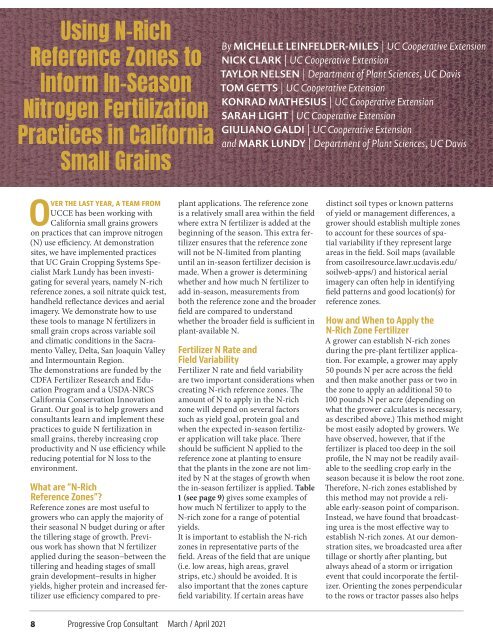PCC MarchApril Final Draft
Create successful ePaper yourself
Turn your PDF publications into a flip-book with our unique Google optimized e-Paper software.
Using N-Rich<br />
Reference Zones to<br />
Inform In-Season<br />
Nitrogen Fertilization<br />
Practices in California<br />
Small Grains<br />
By MICHELLE LEINFELDER-MILES | UC Cooperative Extension<br />
NICK CLARK | UC Cooperative Extension<br />
TAYLOR NELSEN | Department of Plant Sciences, UC Davis<br />
TOM GETTS | UC Cooperative Extension<br />
KONRAD MATHESIUS | UC Cooperative Extension<br />
SARAH LIGHT | UC Cooperative Extension<br />
GIULIANO GALDI | UC Cooperative Extension<br />
and MARK LUNDY | Department of Plant Sciences, UC Davis<br />
Over the last year, a team from<br />
UCCE has been working with<br />
California small grains growers<br />
on practices that can improve nitrogen<br />
(N) use efficiency. At demonstration<br />
sites, we have implemented practices<br />
that UC Grain Cropping Systems Specialist<br />
Mark Lundy has been investigating<br />
for several years, namely N-rich<br />
reference zones, a soil nitrate quick test,<br />
handheld reflectance devices and aerial<br />
imagery. We demonstrate how to use<br />
these tools to manage N fertilizers in<br />
small grain crops across variable soil<br />
and climatic conditions in the Sacramento<br />
Valley, Delta, San Joaquin Valley<br />
and Intermountain Region.<br />
The demonstrations are funded by the<br />
CDFA Fertilizer Research and Education<br />
Program and a USDA-NRCS<br />
California Conservation Innovation<br />
Grant. Our goal is to help growers and<br />
consultants learn and implement these<br />
practices to guide N fertilization in<br />
small grains, thereby increasing crop<br />
productivity and N use efficiency while<br />
reducing potential for N loss to the<br />
environment.<br />
What are “N-Rich<br />
Reference Zones”?<br />
Reference zones are most useful to<br />
growers who can apply the majority of<br />
their seasonal N budget during or after<br />
the tillering stage of growth. Previous<br />
work has shown that N fertilizer<br />
applied during the season−between the<br />
tillering and heading stages of small<br />
grain development−results in higher<br />
yields, higher protein and increased fertilizer<br />
use efficiency compared to preplant<br />
applications. The reference zone<br />
is a relatively small area within the field<br />
where extra N fertilizer is added at the<br />
beginning of the season. This extra fertilizer<br />
ensures that the reference zone<br />
will not be N-limited from planting<br />
until an in-season fertilizer decision is<br />
made. When a grower is determining<br />
whether and how much N fertilizer to<br />
add in-season, measurements from<br />
both the reference zone and the broader<br />
field are compared to understand<br />
whether the broader field is sufficient in<br />
plant-available N.<br />
Fertilizer N Rate and<br />
Field Variability<br />
Fertilizer N rate and field variability<br />
are two important considerations when<br />
creating N-rich reference zones. The<br />
amount of N to apply in the N-rich<br />
zone will depend on several factors<br />
such as yield goal, protein goal and<br />
when the expected in-season fertilizer<br />
application will take place. There<br />
should be sufficient N applied to the<br />
reference zone at planting to ensure<br />
that the plants in the zone are not limited<br />
by N at the stages of growth when<br />
the in-season fertilizer is applied. Table<br />
1 (see page 9) gives some examples of<br />
how much N fertilizer to apply to the<br />
N-rich zone for a range of potential<br />
yields.<br />
It is important to establish the N-rich<br />
zones in representative parts of the<br />
field. Areas of the field that are unique<br />
(i.e. low areas, high areas, gravel<br />
strips, etc.) should be avoided. It is<br />
also important that the zones capture<br />
field variability. If certain areas have<br />
distinct soil types or known patterns<br />
of yield or management differences, a<br />
grower should establish multiple zones<br />
to account for these sources of spatial<br />
variability if they represent large<br />
areas in the field. Soil maps (available<br />
from casoilresource.lawr.ucdavis.edu/<br />
soilweb-apps/) and historical aerial<br />
imagery can often help in identifying<br />
field patterns and good location(s) for<br />
reference zones.<br />
How and When to Apply the<br />
N-Rich Zone Fertilizer<br />
A grower can establish N-rich zones<br />
during the pre-plant fertilizer application.<br />
For example, a grower may apply<br />
50 pounds N per acre across the field<br />
and then make another pass or two in<br />
the zone to apply an additional 50 to<br />
100 pounds N per acre (depending on<br />
what the grower calculates is necessary,<br />
as described above.) This method might<br />
be most easily adopted by growers. We<br />
have observed, however, that if the<br />
fertilizer is placed too deep in the soil<br />
profile, the N may not be readily available<br />
to the seedling crop early in the<br />
season because it is below the root zone.<br />
Therefore, N-rich zones established by<br />
this method may not provide a reliable<br />
early-season point of comparison.<br />
Instead, we have found that broadcasting<br />
urea is the most effective way to<br />
establish N-rich zones. At our demonstration<br />
sites, we broadcasted urea after<br />
tillage or shortly after planting, but<br />
always ahead of a storm or irrigation<br />
event that could incorporate the fertilizer.<br />
Orienting the zones perpendicular<br />
to the rows or tractor passes also helps<br />
8 Progressive Crop Consultant March / April 2021


















